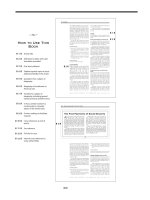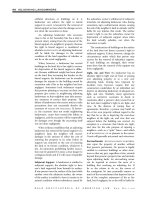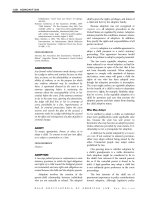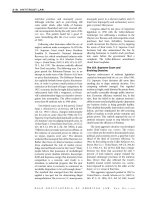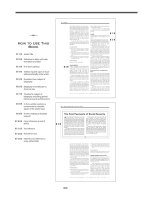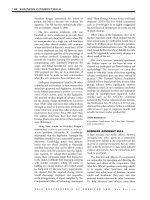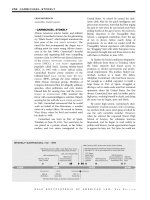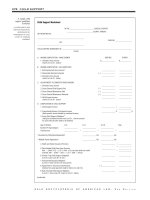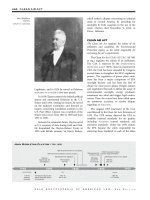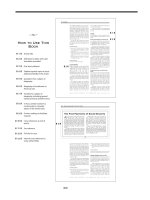Gale Encyclopedia Of American Law 3Rd Edition Volume 5 P2 potx
Bạn đang xem bản rút gọn của tài liệu. Xem và tải ngay bản đầy đủ của tài liệu tại đây (1.01 MB, 10 trang )
k
How to Use This
Book
1
1
2
4
3
2
3
4
5
6
7
8
9
10
11
12
13
XIII
5
6
7
9
10
13
12
11
8
GALE ENCYCLOPEDIA OF AMERICAN LAW, 3RD E DITION
XIV HOW TO USE THIS BOOK
Contributors
Editorial Reviewers
Patricia B. Brecht
Matthew C. Cordon
Frederick K. Grittner
Halle Butler Hara
Scott D. Slick
Contributing Authors
Richard Abowitz
Paul Bard
Joanne Bergum
Michael Bernard
Gregory A. Borchard
Susan Buie
James Cahoy
Terry Carter
Stacey Chamberlin
Sally Chatelaine
Joanne Smestad Claussen
Matthew C. Cordon
Richard J. Cretan
Lynne Crist
Paul D. Daggett
Susan L. Dalhed
Lisa M. DelFiacco
Suzanne Paul Dell’Oro
Heidi Denler
Dan DeVoe
Joanne Engelking
Mark D. Engsberg
Karl Finley
Sharon Fischlowitz
Jonathan Flanders
Lisa Florey
Robert A. Frame
John E. Gisselquist
Russell L. Gray III
Frederick K. Grittner
Victoria L. Handler
Halle Butler Hara
Lauri R. Harding
Heidi L. Headlee
James Heidberg
Clifford P. Hooker
Marianne Ashley Jerpbak
David R. Johnstone
Andrew Kass
Margaret Anderson Kelliher
Christopher J. Kennedy
Anne E. Kevlin
John K. Krol
Lauren Kushkin
Ann T. Laughlin
Laura Ledsworth-Wang
Linda Lincoln
Theresa J. Lippert
Gregory Luce
David Luiken
Frances T. Lynch
Jennifer Marsh
George A. Milite
Melodie Monahan
Sandra M. Olson
Anne Larsen Olstad
William Ostrem
Lauren Pacel li
Randolph C. Park
Gary Peter
Michele A. Potts
Reinhard Priester
Christy Rain
Brian Roberts
Debra J. Rosenthal
Mary Lahr Schier
Mary Scarbrough
Stephanie Schmitt
Theresa L. Schulz
John Scobey
Kelle Sisung
James Slavicek
Scott D. Slick
David Strom
Linda Tashbook
Wendy Tien
M. Uri Toch
Douglas Tueting
Richard F. Tyson
Christine Ver Ploeg
George E. Warner
Anne Welsbacher
Eric P. Wind
Lindy T. Yokanovich
XV
v
FRIEDAN, BETTY NAOMI
GOLDSTEIN
In 1963 author Betty Naomi Goldstein Friedan’s
first book, The Feminine Mystique, launched the
feminist movement, which eventually expanded
the lifestyle choices for U.S. women. By the 1990s,
she had also become a spokesperson for older and
economically disadvantaged people and was
recognized and honored by women outside the
United States for her global leadership and
influence on women’sissues.
She was born Elizabeth Naomi Goldstein on
February 4, 1921, in Peoria, Illinois. Her father,
Harry Goldstein, was a successful storeowner
who emigrated from Russia. Her mother,
Miriam Horowitz Goldstein, graduated from
Bradley Polytechnic
INSTITUTE and wrote society
news as a Peoria newspaper journalist. Friedan
entered Smith College in 1939, majored in
psychology, and served as editor of the college
newspaper. After graduating summa cum laude
in 1942, she interviewed for the only type of job
available to women journalists at the time:
researcher for a major U.S. news magazine. But
the position of researcher amounted to doing all
the work while someone else received the
byline, and Friedan was not interested in that.
Instead, she wrote for a Greenwich Village news
agency, covering the labor movement.
When
WORLD WAR II end ed, Friedan lost her
job to a returning veteran. (Returning veterans
were guaranteed their pre-war jobs.) Friedan
then thought of going to medical school, a choice
very few women could pursue. But instead, she
followed the traditional path, marrying returnin g
veteran CarlFriedan in1947 and starting a family.
After her first child was born, she worked for
another newspaper, but was fired when she
became pregnant with her second child. She
protested to the newspaper guild, as no one had
ever questionedher abilityto perform her job, but
was told that losing her job was “her fault”
because she was pregnant. At that time, the term
sex
DISCRIMINATION did not exist.
While she was a mother and housewife living
in suburban New York, Friedan wrote articles for
women’smagazinessuchasMcCall’s and Ladies’
Home Journal on a freelance basis. Tapped by
McCall’s to report on the state of the alumnae of
the Smith class of 1942 as they returned for their
fifteenth reunion in 1957, Friedan visited the
campus and was struck by the students’ lack of
interest in careers after graduation. This disinter-
est in intellectual pursuits contrasted greatly with
Friedan’s perception of her Smith classmates of
the 1930s and 1940s.
Extensive research over the next several years
brought Friedan to the conclusion that women’s
magazines were at
FAULT because they defined
women solely in relationship to their husbands
and children. This had not always been the
case; the magazines had evolved in the postwar
years from promoters of women’s
INDEPENDENCE
into paeans to consumerism, bent on keeping
F
(cont.)
MEN WEREN’T
REALLY THE ENEMY
—
THEY WERE FELLOW
VICTIMS SUFFERING
FROM AN OUTMODED
MASCULINE
MYSTIQUE THAT
MADE THEM FEEL
UNNECESSARILY
INADEQUATE WHEN
THERE WERE NO
BEARS TO KILL
.
—BETTY FRIEDAN
1
U.S. housewives in the home by selling them
more and more household products.
Not surprisingly, Friedan was unable to
get her work on this issue published in an
acceptable format by the women’s magazines
she was criticizing. Her report was published in
book form in 1963 as The Feminine Mystique, in
which she chronicled the dissatisfaction of
suburban housewives, dubbing it “the problem
with no name.” The book struck a common
chord among U.S. women, who recognized
themselves in the women she described in its
pages. For the first time since the women’s
SUFFRAGE movement ended successfully with the
passage of the
NINETEENTH AMENDMENT granting
women the right to vote, women gathered
together on a large scale to work for equal rights
with men, a concept that at the time was
nothing less than revolutionary.
In 1966, with Kathryn Clarenbach, Friedan
cofounded the
NATIONAL ORGANIZATION FOR
WOMEN
(NOW). NOW’s original statement of
purpose was written by Friedan: “Women want
feminism to take the actions needed to bring
women into the mainstream of American society,
now; full equality for women, in fully equal
partnership with men.” Friedan served as NOW’s
president until 1970. Under her leadership,
NOW propelled the women’smovementfrom
middle-class suburbia to nationwide activism.
Friedan also helped organize the National
ABORTION Rights Action League (now NARAL
PRO
-CHOICE AMERICA) in 1969, and the National
Women’s Political Caucus in 1971. All three
organizations were still active participants in U.S.
politics and culture into the 2000s.
On August 26, 1970, the fiftieth anniversary
of the
RATIFICATION of the Nineteenth Amend-
ment, the Women’s Strike for Equality took
place. Friedan’s brainchild, this women’s rights
demonstration was the largest that had ever
occurred in the United States. Thousands of U.S.
women marched in the streets for a day rather
than working as housewives, secretaries, and
waitresses, to show how poorly society would
fare without women’s labor and to demand three
things for women: equal opportunity in employ-
ment and education, 24-hour
CHILD CARE centers,
and legalized abortion. Although the media at
▼▼
▼▼
Betty Naomi Goldstein Friedan 1921–2006
1900
1950
1975
2000
1925
❖◆
◆◆◆◆◆
◆◆ ◆ ◆ ❖
1921 Born,
Peoria, Ill.
1942 Graduated
summa cum
laude from
Smith College
1963 The Feminine
Mystique published
1966 Founded National
Organization for Women
with Kathryn Clarenbach
1966–70 Served as
president of NOW
1969 Helped found
the National Abortion
Rights Action League
1971 Founded the
National Women’s
Political Caucus with
Gloria Steinem and
Bella Abzug
1986 Supported California’s
law requiring four month
unpaid maternity leave
2006 Died,
Washington, D.C.
1995 Spoke at the
U.N. Fourth World
Conference on
Women in Beijing
1920 Nineteenth Amendment
ratified, established right
of women to vote
1973 Roe v. Wade
decision legalized
abortion in the
United States
1981 Sandra Day
O’Connor became
first female U.S.
Supreme Court
justice
1993 Family and
Medical Leave Act
took effect
◆◆
2000
Life so Far
published
Betty Friedan.
COURTESY OF THE
UNIVERSITY OF
CALIFORNIA
GALE ENCYCLOPEDIA OF AMERICAN LAW, 3RD E DITION
2 FRIEDAN, BETTY NAOMI GOLDSTEIN
the time portrayed the strike as FRIVOLOUS or a
result of female hysteria, their compulsion to pay
the event any attention at all was a step forward
for the women’smovement.
By the 1980s it was apparent that Friedan’s
feminism differed from that of other U.S.
feminists such as
GLORIA STEINEM and Kate Millett.
When other feminist leade rs were saying women
could “have it all,” meaning a successful career,
fulfilling
MARRIAGE, and happy children, Friedan,
who had been divorced from her husband since
1969, wrote articles such as “Being ‘Superwoman’
Is Not the Way to Go” (Woman’sDay,Oct. 1981)
and “Feminism’s Next Step” (New York Times
Magazine, July 1981). Rather than focusing on
sexual violence and abortion rights, Friedan’s
writings emphasized the necessity of working
with other groups to improve the plight of
children, members of minorities, and economi-
cally disadvantaged people.
In her 1981 book The Second Stage, Friedan
called for an open discussion of traditional
feminism’s denial of the importance of family
and of women’s needs to nurture and be
nurtured. She predicted that the women’s
movement would die out if feminists did not
take the issues of children and men more
seriously. It was not surprising that this position
was roundly criticized as antifeminist by many
of Friedan’s contemporaries.
Another position that was at odds with
NOW surfaced in 1986 when she declared her
support for a California law requiring emplo y-
ers to grant up to four months of unpaid leave
for women who were disabled by pregnancy
or childbirth. The 1980 law (West’s Ann. Cal.
Gov. Code § 12945) was the subject of a U.S.
Supreme Court case, California
FEDERAL Savings
and Loan Ass’n v. Guerra, 479 U.S. 272, 107 S.
Ct. 683, 93 L. Ed. 2d 613 (1987). NOW opposed
the law as a dangerous singling out of women
for special treatment; Friedan called it outra-
geous that feminists would side with employers
who were trying to evade offering women
important and needed benefits. These opinions,
among other things, caused Friedan to lose
support within the women’s movement as well
as an audience in the media.
Another reason for Friedan’sfallfrommedia
attention was her style, which, like her philoso-
phy, also differed from that of other feminist
spokespersons, most notably Steinem. Whereas
Steinem was a favorite of the media and actively
courted their attention, Friedan did not seek out
media attention and often railed against what she
saw as the stereotyping of women. Her stormy
relationship with the media contributed to an
image of her as old, unattractive, and out of
touch with modern feminism.
By 1990, although Friedan was moving
away from what was considered mainstream
feminism, she had earned a permanent place
in history. That year, Life magazine named her
one of the 100 most imp ortant peop le of the
twentieth century.
In September 1995, a new generation of
journalists seemed surprised at Friedan’s exten-
sive international influence, which was demon-
strated at the Non-Governmental Organization
Forum on Women, an unofficial gathering at
the U.N. Fourth World Conference on Women.
Friedan attended the forum as one of only a few
women who had participated in all four U.N.
women’s conferences since the first one was
held in Mexico City in 1975. Women of all
nationalities and ages sought her out, listened to
her speeches, and attended her workshops.
Friedan’s focus was to move the women’s
movement away from conflict with men and
toward economic policies that benefited both
sexes, such as shorter workweeks and higher
minimum wages. As she saw it, policies that were
pro-women alone were portrayed in the media
and by opponents as anti-family and anti-men.
Poor economic conditions and shrinking job
opportunities often resulted in the treatment of
women’s developing economic power as a
scapegoat for difficulties suffered by men or
families. In Friedan’sopinion,thisunnecessary
tension between men and women diverted
attention from the issues that really threatened
the well-being of women and families: poverty,
unemployment, lack of education and health
care, and crime. To combat these problems, she
supported a proposal put forth by distinguished
academics and public policy researchers that
would provide low-income parents, not just
women on
WELFARE,withHEALTH INSURANCE and
child care.
Friedan’s focus on more gender-neutral
policies was an outgrowth of her research into
gerontology and the issues facing aging people.
The 1993 publication of The Fountain of Age
had put Friedan back in the media spotlight
as the spokesperson of her generation, an advo-
cate for freeing older people from damaging
GALE ENCYCLOPEDIA OF AMERICAN LAW, 3RD E DITION
FRIEDAN, BETTY NAOMI GOLDSTEIN 3
stereotypes, just as she had previously done for
women. Friedan brought to her advocacy for
older people her philosophy of cooperation,
developed during her decades of work in the
women’s movement. A
DELEGATE to the Fourth
White House Conference on Aging in 1995, she
fought against the polarization of young and
older U.S. citizens that some politicians encour-
aged in order to increase their political power.
She eschewed the idea of forced retirement,
instead arguing for older workers to voluntarily
and gradually cut down their work schedules
and to explore job sharing and consultant work.
At the same time, Friedan vowed to save
programs such as
SOCIAL SECURITY, MEDICARE,
and
MEDICAID, which were under attack by FISCAL
conservatives. With that full plate of issues, it
was clear that she was not ready to stop her
advocacy work.
In the late 1990s, Friedan continued to
speak at schools and other forums around the
country and throughout the world. She wrote
for a number of publications and taught at
several schools, including the University of
California, New York University, and Mount
Vernon College in Washington, D.C, where she
was the Distinguished Professor of Social
Evolution. She has also served as an adjunct
scholar at the Smithsonian Institution’s Wilson
International Center for Scholars. In 1993 she
was inducted into the National Women’sHall
of Fame. In 2000 she published her autob iog-
raphy, Life So Far. Friedan died of congestive
heart failure at her home in Washington, D.C.,
on February 4, 2006, her 85th birthday.
FURTHER READINGS
Evans, Sara. 1980. Personal Politics: The Roots of Women’s
Liberation in the Civil Rights Movement and the New
Left. New York: Random House.
Horowtiz, Daniel. 2000. Betty Friedan and the Making
of “The Feminine Mystique”: The American Left, the
Cold War, and Modern Feminism. Boston: Univ of
Massachusetts Press.
CROSS REFERENCES
Age Discrimination; Ireland, Patricia; Sex Discrimination.
FRIEND OF THE COURT
A person who has a stron g interest in a matter
that is the subject of a lawsuit in which he or she is
not a party.
A
FRIEND OF THE COURT may be given
permission by the court to file a written
statement of his or her views on the subject,
ostensibly to bolster the case of one party but
even more to persuade the court to adopt the
party’s views. The Latin translation,
AMICUS
CURIAE
, is used most often for a friend of the
court; the written argument that he or she files
may be called an amicus curiae
BRIEF.
FRIENDLY FIRE
Fire burning in a place where it was intended to
burn, although damages may result. In a military
conflict, the discharge of weapons against one's
own troops.
A fire burning in a fireplace is regarded as a
friendly fire, in spite of the fact that extensive
smoke damage might result therefrom. Ordi-
narily, when an individual purchases fire
insurance, the coverage does not extend to
damages resulting from a friendly fire but only
to loss resulting from an uncontrollable hostile
fire.
v
FRIENDLY, HENRY JACOB
Henry Jacob Friendly served for 27 years on
the U.S. Court of Appeals for the Second
Circuit, where he won a wide reputation for
his scholarly, well-crafted opinions.
Friendly was born July 3, 1903, in Elmira,
New York. He graduated summa cum laude from
Harvard College in 1923 and from Harvard Law
School in 1927. In law school he studied under
Professor
FELIX FRANKFURTER, later a U.S. Supreme
Court Justice, who recommended Friendly for a
clerkship with Supreme Court Justice
LOUIS D.
BRANDEIS. After his clerkship Friendly entered
private practice wher e he specialized in railroad
reorganizations and corporate law. He later
became a
VICE PRESIDENT and general counsel for
Pan American Airways.
In 1959 President
DWIGHT D. EISENHOWER
appointed Friendly to the U.S. Court of Appea ls
for the Second Circuit, where he remained until
his deat h. Although Friendly was a semi-retired
senior judge during his last years on the court,
he remained an active participant and was
involved in more than one hundred cases each
year. He served as chief judge of the court from
1971 to 1973. In 1974 Friendly took on the
additional duties of the presiding judge of the
Special Railroad Court, which was established to
deal with the reorganization of rail service in the
Northeast and the Midwest that resulted from
GALE ENCYCLOPEDIA OF AMERICAN LAW, 3RD E DITION
4 FRIEND OF THE COURT
the BANKRUPTCY of the Penn Central Railroad
and the former Conrail.
Friendly wrote nearly a thousand judicial
opinions as well as a number of notes and
articles on a wide range of issues, but he is
probably best known for his work in the areas of
diversity
JURISDICTION, CRIMINAL PROCEDURE, and
SECURITIES law. Diversity jurisdiction refers to the
jurisdiction that federal courts have over law-
suits in which the plaintiff and the
DEFENDANT
are residents of different states. Friendly first
became interested in the subject when he was in
law school, and one of his first articles was “The
Historic Basis of Diversity Jurisdiction,” 41
Harvard Law Review 1928. Later, after the U.S.
Supreme Court had established a new precedent
for cases involving diversity jurisdiction (Erie
Railroad
CO. V. Tompkins, 304 U.S. 64, 58 S. Ct.
817 82 L. Ed. 1188 [1938]). Friendly wrote, “In
Praise of Erie—and of the New
FEDERAL
Common Law,” 39 New York University Law
Review, 1964. A few years later he provided an
overview of federal jurisdiction in Federal
Jurisdiction: A General View (1973).
Pat Tillman
E
B
ven though friendly fire is a recognized hazard
of modern warfare, particular incidents garner
public attention. One example is that of Pat Tillman,
a star collegiate and National Football Lea gue player
who gave up a multi-million dollar pro football
contract to join the U.S. Army after September 11,
2001. Tillman became an Army Ranger and a member
of an infantry regiment that was deployed to
Afghanistan, where he was killed on April 22, 2004.
The circumstances of his death were first portrayed
as the result of a firefight with Taliban fighters,
leading t o Corporal Tillman’s elevation as a special
American hero. However, three weeks later, the
Army revealed that he had died of friendly fire, and
Tillman’s mother and his brother K evin, also a
Ranger, expressed concerns over two fact-finding
investigations by his regiment, believing there was a
conspiracy to conceal the true facts of his death.
The revelation in May 2004 that Till man had
been shot by his comrades took the public by
surprise. His commanding general had q uickly
awarded Tillman the Silver Star, the Purple Heart,
and a po sthumous promotion, knowing he had died
of friendly. Lt. Gen. Stanley McChrystal approved
the Silver Star citation six days after Tillman’s
death, which included a narrative regarding
Tillman’s death that included the phrase “in the
line of devastating enemy fire.” However, the next
day he sent a memo to senior government officials
that warned of the possibility Tillman might have
been killed by friendly fire. Nevertheless, these
officials allowed a nationally televised memorial
service to go forward, in w hich a false account of
his death was given. There were later reports t hat
members of Tillman’s unit were told to lie to the
family about his death.
Troubling details began to emerged that sug-
gested his unit attempted to cover up his dea th by
friendly fire. His body armor an d uniform, along with
his personal journal were burned, which violated
Army rules. Though several members of his un it
were discharg ed from the Army or disciplined,
Tillman’s family was not convinced it had heard the
true story. They feared that Tillman might have been
killed because he had become disenchanted with
the war. Their complaints led the Army inspector
general to open an investigation in August 2005.
In March 2006 the Defense Department inspec-
tor general dire cted the Army to open a criminal
investigation into Tillman’s death, which r esulted in
a report, filed in March 2007, that provided no new
information. It concluded that the death was
accidental and that the initial reports that he died
of hostile fire were based on confusion the day of
the fire fight. The House of Representatives
CommitteeonOversightandGovernmentReform
conducted its own investigation an d released a
report in July 2008 that criticized “ the pervasive lack
of recol lection and absence of specific information”
that made it impossible for it to assign responsibility
for the misinfo rmation in Tillman’s death.
FURTHER READINGS
Krakauer, John. 2009. Where Men Win Glory: The Odyssey of
Pat Tillman. New York: Doubleday.
Tillman, Mary. 2008 Boots on the Ground: My Tribute to Pat
Tillman. New York: Modern Times.
GALE ENCYCLOPEDIA OF AMERICAN LAW, 3RD E DITION
FRIENDLY, HENRY JACOB 5
During the 1960s Friendly became involved
in the debate over changes in criminal proce-
dure that were occurring as the U.S. Supreme
Court, in a series of decisions, held that many of
the rights guaranteed in the
BILL OF RIGHTS
applied to the states. In “The Bill of Rights as a
Code of Criminal Procedure,” Benchmarks
(1967), Friendly expressed doubts about some
of the Court’s decisions and worried that they
would cut off debate in Congress and the state
legislatures that might have proved fruitful in
developing new solutions to the problems of
criminal procedure. He also criticized the
decision in
MIRANDA V. ARIZONA, 384 U.S. 436,
86 S. Ct. 1602, 16 L. Ed. 2d 694 (1966), on the
ground that it was predicated on the unfounded
ASSUMPTION that all custodial interrogations are
inherently coercive.
In the area of securities law, Friendly wrote
more than one hundred opinions, several of
them in the relatively new field of
TRANSNATIONAL
LAW
, which deals with corporations that have
activities in several countries. He was also
notably unsympathetic toward white-collar
criminals who perpetrated financial frauds; in
United States v. Benjamin, 328 F.2d 854 (1954),
he observed that “[i]n our complex society the
accountant’s certificate and the lawyer’s opinion
can be instruments for inflicting pecuniary loss
more potent than the chisel or the crowbar.”
Friendly’s colleag ues respected him for his
scholarship, his reasoning, and his self-restraint.
In 1977 he receive d the Presidential Medal of
Freedom from President
GERALD R. FORD for
having brought “a brilliance and a sense of
precision to American
JURISPRUDENCE, sharpen-
ing its focus and strengthening its commitment
to the high goal of equal and exact justice for
every American citizen.” As another federal
JURIST, JOHN MINOR WISDOM, put it, Friendly
was “unsurpassed as a judge—in the power
of his reas oning, the depth of his knowledge
of the law, and his balanced judgment in
decision-making.”
In 1985, Sophie Stern, Friendly’s wife of 55
years, died. Despondent over her death and
plagued by failing eyesight, Friendly took his
own life in his New York City apartment on
March 11, 1986.
FURTHER READINGS
Boudin, Michael. 2007. “Judge Henry Friendly and the
Mirror of Constitutional Law.” New York Univ. Law
Review (October) 82. Available online at .
nyu.edu/ecm_dlv/groups/public/@nyu_law_website__
journals__law_review/documents/documents/ecm_dlv_
015190.pdf; website home page: .
edu (accessed September 3, 2009).
“Henry Jacob Friendly.” Judges of the United States. Federal
Judicial Center Web site. Available online at http://
www.fjc.gov/servlet/tGetInfo?jid=802;
(accessed September 3, 2009).
Norman, Michael. “Henry J. Friendly, Federal Judge in
Court of Appeals, Is Dead at 82.” The New York Times
(March 12, 1986).
FRIENDLY SUIT
A lawsuit brought by an executor or administrator
of the estate of a deceased person in the name of a
creditor as if that creditor had initiated the action.
The executor or administrator brings the suit
against himself or herself in order to compel the
creditors to take an equal distribution of the assets
of the estate. An action brought by parties who
agree to submit some doubtful question to the
court in order to obtain an opinion on that issue.
▼▼
▼▼
Henry Jacob Friendly 1903–1986
19001900
19501950
19751975
20002000
19251925
❖
1903 Born,
Elmira, N.Y.
1914–18
World War I
1927–28
Clerked for
Supreme
Court Justice
Brandeis
1939–45
World War II
1950–53
Korean War
1946–59 Served as
general counsel and vice
president of Pan
American World Airways
1961–73
Vietnam War
1959–86 Served on the U.S. Court
of Appeals for the Second Circuit
◆
1967 In a Benchmarks article, Friendly
questioned the High Court's decisions on civil
procedure in Mapp, Gideon, and Miranda
◆
1986 Died,
New York City
1977 Received the Presidential Medal of Freedom
◆
1973 Federal Jurisdiction: A General View published
1971–73 Served as chief judge of the Second Circuit
❖
THE QUESTION OF
HOW JUDGES GO
ABOUT THE B USINESS
OF JUDGING
CONTINUES TO H OLD
INTEREST
—ALTHOUGH
APPARENTLY MORE
FOR L AWYE RS A ND
LAW PROFESSOR S
THAN FOR JUDGES
.
—HENRY FRIENDLY
GALE ENCYCLOPEDIA OF AMERICAN LAW, 3RD E DITION
6 FRIENDLY SUIT
FRIES’S REBELLION
John Fries was an auctioneer from rural
Pennsylvania who led a small group of tax
protesters in what cam e to be known as Fries’s
Rebellion. He was tried and convicted of
TREASON but was eventually pardoned.
Fries served as a captain in the Continental
Army during the
WHISKEY REBELLION of 1794. He
then returned to Pennsylvania to resume his life
there. In 1798, Congress authorized the collec-
tion of prop erty taxes to replenish funds
depleted by the Whiskey Rebellion and to
finance an anticipated war with France. Reve-
nue officers were sent to all parts of the United
States to assess the value of homes, land, and
slaves for
TAXATION. The tax assessment was well
publicized and understood in urban areas,
where most residents paid little attention to
the assessors’ activities. However, in the rural
regions of northeastern Pennsylvania, where
many residents spoke and read only German,
many people were unaware of Congress’s action
and were resentful and fearful of the inquisitive
assessors. They responded by attac king the
revenue officers, both verbally and physically.
Their treatment of the assessors was dubbed the
Hot Water War, after an incident in which a
woman dumped a bucket of hot water on a
revenue agent.
The Pennsylvanians’ protests escalated until
a group of residents took several revenue
officers captive and held them until they had
satisfactorily explained their actions. Upon their
release, the officers arrested twenty-three men
for
INSURRECTION. Fries and a group of men who
believed that the property tax was a deprivation
of liberty took up arms and liberated their
detained comrades. When the group resisted
orders from President
JOHN ADAMS to disperse
and to allow the
FEDERAL officers to carry out
their duties, Fries and its other leaders were
arrested for treason.
Fries was brought to trial in 1799, before
Judge Richard Peters, of the Pennsylvania
district court, and Justice
JAMES IREDELL, of the
Supreme Court. Fries ’s
DEFENSE counsel argued
that their client’s offense was a simple protest
that perhaps could be characterized as sedition,
but certainly did not rise to the level of treason,
a capital crime. They contended that, in a free
republic, the treason charge should be reserved
for the most extreme cases of armed attempt to
overthrow the government.
Defense counsel’s pleas for freedom of
expression of political sentiment did not
convince members of the jury, who were
probably influenced by Iredell’s and Peters’s
INSTRUCTIONS. In those instructions, Peters
equated opposing or preventing the implemen-
tation of a law with treason, and Iredell agreed
with him. Fries was found
GUILTY, but was
granted a new trial when the court learned that
before the trial began, one juror had expressed a
belief in his guilt.
Fries’s second trial took place in April 1800,
before Justice Samuel Chase, of the Supreme
Court, and Judge Peters. Determined to expedite
the second trial, Chase took the unprecedented
step of preparing an opinion on the
LAW OF THE
CASE
. Before the trial began, he distributed copies
of his summary to the defense attorneys, the
DISTRICT ATTORNEY, and the jury. Chase made it
clear thathis opinion represen ted the court’s view
of the law of treason and that the defense would
not be permitted to present lengthy arguments to
the contrary, as it had in the first trial.
Outraged that the court had prejudged their
client’s case, Fries’s attorneys withdrew from the
In 1800, William W.
Woodword, a
Philadelphia
publisher, used
shorthand notes taken
by Thomas Carpenter
to produce a report of
John Fries’s two trials
for treason.
LIBRARY COMPANY OF
PHILADELPHIA
GALE ENCYCLOPEDIA OF AMERICAN LAW, 3
RD E DITION
FRIES’ S REBELLION 7
